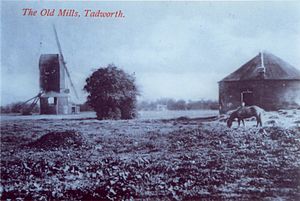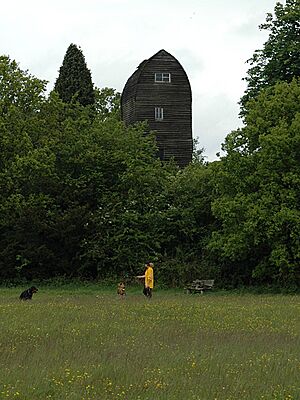New Mill, Tadworth facts for kids
Quick facts for kids Tadworth Windmill |
|
|---|---|

The mill c.1910, with the roundhouse of the other mill in the foreground
|
|
| Origin | |
| Mill name | New Mill |
| Grid reference | TQ 236 555 |
| Coordinates | 51°17′06″N 0°13′44″W / 51.285°N 0.229°W |
| Operator(s) | Private |
| Year built | c1762 |
| Information | |
| Purpose | Corn mill |
| Type | Post mill |
| Roundhouse storeys | Two storeys |
| No. of sails | Four sails |
| Type of sails | Spring Patent sails |
| Windshaft | Cast iron |
| Winding | Tailpole |
| No. of pairs of millstones | Two pairs |
| Other information | Tallest surviving post mill in Surrey |
New Mill is a very old and important windmill located in Tadworth, Surrey, England. It's officially recognized as a Grade II listed building, which means it's a special historic place. Currently, it's also on a list called the Buildings at Risk Register, meaning it needs some care and repairs.
History of New Mill
It's not exactly known when New Mill was built, but experts believe it was around the mid-1700s. Windmills have been in Surrey for a very long time! One was noted in Walton-on-the-Hill way back in 1295.
A windmill in Tadworth was sold in 1600. Another one on Banstead Common was mentioned in a survey from 1680. An important document from Parliament in 1755 also talked about the windmill. It even appeared on a map made in 1762.
The mill used to grind grain using wind power. In 1893, it lost two of its sails. It kept working with wind until 1902, sometimes getting help from a steam engine. Another similar windmill stood nearby until 1890.
Challenges and Repairs
In 1921, during a dry period, the mill lost its last two sails. The mill was damaged twice during World War II. First, a bomb hit it in 1941, and then a flying bomb caused more damage in 1944.
Repairs were done in 1950 to fix some of the damage. More recently, people have been worried about the mill's condition. In 2009, the local council, Reigate and Banstead Council, agreed to spend £37,000 on urgent repairs. This was because the mill was put on the Buildings at Risk Register. The council even had to tell the owner to do the work, or they would do it themselves and charge the owner.
How New Mill Works
New Mill is a special type of windmill called a post mill. This means the main body of the mill, which holds all the machinery, can turn around a large central post. This helps the mill's sails face the wind.
The mill sits on a two-storey roundhouse. This is the only roundhouse of its kind in Surrey! The mill once had four Spring Patent sails. These sails were attached to a strong cast iron pole called a windshaft.
Inside, a large cast iron wheel, about 8 feet (2.4 meters) wide, helped power the mill. This wheel had 120 teeth! It turned two pairs of millstones, which were used to grind grain into flour. The mill was turned to face the wind using a long pole called a tailpole.
People Who Ran the Mill
Many people worked at New Mill over the years, grinding grain for the community. Here are some of the millers who operated it:
- John May (1780 - 1789)
- George May (1789 - unknown)
- John Smith (1795 - 1831, and again in 1834)
- Mrs E Smith (1845)
- J H Smith (1874 - 1878)
- E W Smith (1887 - 1903)


